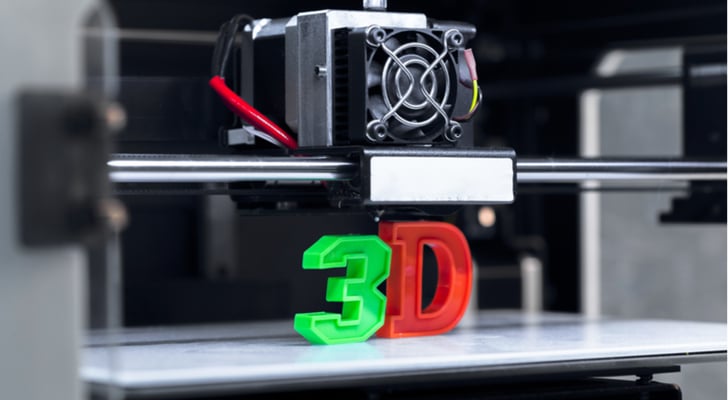When the concept initially launched, 3-D printers, and later, 3-D printing stocks, captured investors’ attention. While the technology to print three-dimensional objects existed earlier, this was the first time it was brought to retail. Now, anybody with a dream — and some computer skills — could turn their vision into reality.
Or so early-bird investors thought. Earlier this decade when we saw initial public offerings for many 3-D printing stocks, enthusiasm was sky-high. Proponents expected the sector to impart a radical paradigm shift.
Really, who could blame them? For better or for worse, 3-D printers decentralized the conceptual manufacturing process. Tinkerers could tinker away without incurring onerous overhead.
But the problem was that the markets quickly found 3-D printing stocks as niche novelty items. From wildly optimistic valuations, the newly christened industry tumbled harder than the most farfetched, speculative tech IPO. Stalwarts like 3D Systems (NYSE:DDD), ExOne (NASDAQ:XONE) and Voxeljet (NYSE:VJET) are all down sharply from their initial releases.
Basically, the only way to profit from 3-D printing stocks was to catch them at their low point. From there, much prayer, and perhaps an animal sacrifice or two could get the job done.
I know this firsthand. On Feb. 24, 2016, I covered the three companies mentioned above. Since then, DDD stock is up nearly 32%, which is okay given the time frame. But the performances for XONE and VJET, which are down 18% and 16%, respectively, are disappointing and unacceptable.
If you happen to be profitable on DDD stock, I’d take the money and run. I learned a tough lesson about this sector, which is that it’s completely unreliable. Even my aforementioned losers were once winners before crumbling, and apparently for good.
What’s Going on With 3-D Printing Stocks?
In my write-up more than two years ago, I thought that the markets were being myopic toward 3-D printing stocks. Rarely do we see an entirely new industry materialize. In this case, 3-D printers forwarded the concept of additive manufacturing, or AM.
But I didn’t blame panicky investors entirely for sector woes. I acknowledged that AM companies were focusing too intently on the technology for its own sake. What was missing was the bridge between “between innovation and application.”
That said, several years have passed since the first 3-D printer hit retail shelves, yet 3-D printing stocks stink. To paraphrase President Trump, just what the heck is going on?
To answer that question, I’m going to reference Occam’s razor. Very loosely speaking, this principle states that the most obvious solution is probably the right one. For our purposes, the obvious explanation is that 3-D printers are mostly hype
with little practical substance.
Misunderstandings can arise from what I just said, so let me clarify. 3-D printers are incredibly powerful, professional devices designed for people who know what they’re doing. In the right hands, for instance, a Stradivarius produces the most exquisite tones you can dream of. But to a lay amateur, it’s simply a museum piece.
An extremely expensive one, mind you. Because that is the other component that hurts 3-D printing stocks: a viable retail market doesn’t exist for these devices because it can’t exist. The best, cheapest 3-D printer will set you back $330. To put that into perspective, you can buy the brand-new Playstation 4 Slim from Sony (NYSE:SNE) for less money.
I can see why the average customer would pay $300 for a PlayStation. It’s fun and addictive. 3-D printing? It’s a novelty act.
More Challenges Ahead for 3-D Printers
Moving forward, I see two significant headwinds for 3-D printing stocks. First, the companies that are involved in this industry run very poor financials. Second, the overall market isn’t that big, and it’s not growing nearly as fast as you might think.
Let’s tackle the first issue. Whether you’re looking at 3D Systems, ExOne or Voxeljet, every one of them have lost money for at least the last three years. By itself, that doesn’t necessarily generate a red flag. But it’s very telling that none of the players, irrespective of size and influence, have positive earnings.
Another point is that the rung-up sales figures are relatively tiny. 3D Systems haul last year was $646 million. ExOne produced less than $58 million, while Voxeljet managed only $27.4 million.
This segues into the second issue, which is that the 3-D printing market is small. Experts predict that by the end of this year, total 3-D printer revenues worldwide will amount to $12 billion. That figure is expected to grow to only $20 billion in 2021, or an average annual growth of 22%.
Like I said earlier, if you’re up on DDD stock, I’d sell. As for the other two 3-D printing stocks, it might be time to consider cutting your losses.
As of this writing, Josh Enomoto is long SNE.

